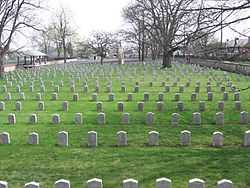Camp Chase
|
Camp Chase Site | |
 | |
|
Some of the thousands of Confederate graves in the Camp Chase Cemetery | |
 | |
| Location | 2900 Sullivant Ave., Columbus, Ohio |
|---|---|
| Coordinates | 39°56′38″N 83°4′33″W / 39.94389°N 83.07583°WCoordinates: 39°56′38″N 83°4′33″W / 39.94389°N 83.07583°W |
| Area | 1.4 acres (0.57 ha) |
| Built | 1861 |
| Governing body | National Park Service |
| NRHP Reference # |
73001434 [1] |
| Added to NRHP | April 11, 1973 |
Camp Chase was a military staging, training and prison camp in Columbus, Ohio, during the American Civil War. All that remains of the camp today is a Confederate cemetery containing 2,260 graves. The cemetery is located in what is now the Hilltop neighborhood of Columbus, Ohio.
History
Camp Chase was a Civil War camp established in May 1861, on land leased by the U.S. Government. It served as a replacement for the much smaller Camp Jackson. The main entrance was on the National Road 4 miles (6.4 km) west of Downtown Columbus, Ohio. Boundaries of the camp were present-day Broad Street (north), Hague Avenue (east), Sullivant Avenue (south), and near Westgate Avenue (west). Named for former Ohio Governor and Lincoln's Secretary of the Treasury Salmon P. Chase, it was a training camp for Ohio volunteer army soldiers, a parole camp, a muster outpost, and a prisoner-of-war camp. The nearby Camp Thomas served as a similar base for the Regular Army.
Four future Presidents passed through Camp Chase: Andrew Johnson, Rutherford B. Hayes, James Garfield, and William McKinley. It also held Confederates captured during Morgan's Raid in 1863, including Col. Basil W. Duke. Early in the war, the prison section held a group of prominent western Virginia and Kentucky civilians suspected of actively supporting secession, including former 3-term United States Congressman Richard Henry Stanton.
The camp was closed in 1865, and by September 1867, dismantled buildings, usable items, and 450 patients from Tripler Military Hospital (also in Columbus) were transferred to the National Soldier's Home in Dayton. In 1895, former Union soldier William H. Knauss organized the first memorial service at the cemetery, and in 1906 he wrote a history of the camp. The Memorial Arch was dedicated in 1902. From 1912 to 1994, the United Daughters of the Confederacy held annual services. The Hilltop Historical Society now sponsors the event on the second Sunday in June.
The Lady in Gray
The Lady in Gray is purportedly an apparition that haunts Camp Chase Cemetery. The story goes that the ghost is looking for her lost love, and cannot find him in the cemetery. The woman is described as young, in her late teens or early twenties, dressed entirely in gray, and carrying a clean white handkerchief. The legend of the Lady in Gray dates back to just after the Civil War, when visitors to Camp Chase spotted the woman walking through the cemetery, trying to read the carved names on the marked grave markers. She was seen quite often for several years, before disappearing completely.[2]
Camp Chase today
Aside from the Confederate Cemetery, which still exists, the land that formerly housed Camp Chase is now a residential and commercial area known as Westgate, a community in the Hilltop section of west Columbus. This development was built in the late 1920s and early 1930s.
See also
- Ohio in the Civil War
- Camp Dennison
- Johnson's Island
- Hilltop Area
- List of Civil War POW Prisons and Camps
References
- ↑ "National Register Information System". National Register of Historic Places. National Park Service. 2009-03-13.
- ↑ "The Washburn Collection: The Grey Lady Ghost". Retrieved 28 September 2011.
- Historical Marker #27-25, located at 2900 Sullivant Avenue, Columbus, Ohio, installed by the Ohio Bicentennial Commission, 1999.
External links
- Comprehensive Camp Chase Cemetery headstone inventory
- Camp Chase Prison
- Camp Chase Confederate Cemetery
- Camp Chase Cemetery on graveaddiction.com
- Camp Chase Cemetery on Rootsweb
- Aerial photo of Camp Chase
- Find-A-Grave: Camp Chase Cemetery
- Knauss, William H.; The story of Camp Chase; 1906
- Not to Be Forgotten: Camp Chase Confederate Cemetery, a National Park Service Teaching with Historic Places (TwHP) lesson plan
- Historic American Landscapes Survey (HALS) No. OH-2, "Camp Chase Confederate Cemetery, 2900 Sullivant Avenue, Columbus, Franklin County, OH"
| |||||||||||||||||||
| ||||||||||||||||||||
